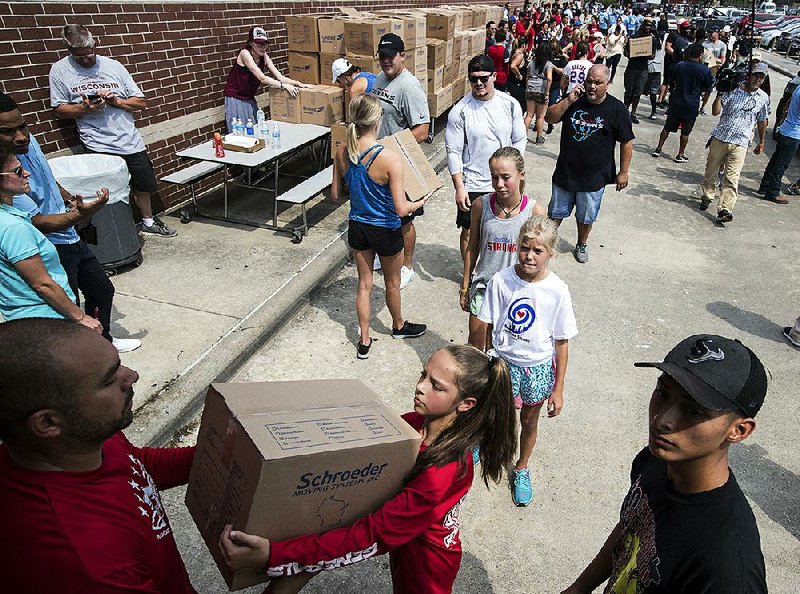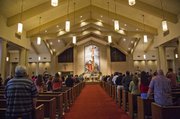HOUSTON -- Texans pressed ahead Sunday with door-to-door searches for frail or elderly survivors, and many residents in Houston returned to their homes in the wake of the most powerful hurricane to strike the continental U.S. in more than a decade.
Meanwhile, authorities carried out a controlled burn at a chemical plant damaged by Harvey that had already been the site of several explosions, saying highly unstable compounds inside needed to be neutralized.
As tens of thousands of people in the Houston area spent the Labor Day holiday weekend cleaning out homes from which Hurricane Harvey's waters had receded, Mayor Sylvester Turner exhorted his constituents to move ahead as quickly as possible toward some semblance of normal in the nation's fourth-largest city.
"I'm encouraging people: 'Get up, and let's get going,'" Turner said on NBC's Meet the Press.
Looking ahead to the Tuesday start of the workweek, Turner addressed area businesses.
"Most of the city is dry, and I'm saying if you can open, let's open up and get started," he urged.
He also said the city is ready to host events again.
"Anyone who was planning on a conference or a convention or a sporting event or a concert coming to this city, you can still come," the mayor said on CBS' Face the Nation. "We can do multiple things at the same time."
But many perils remained, including chemical hazards and damaged infrastructure across the flood zone. The Environmental Protection Agency said Sunday that Administrator Scott Pruitt was in "constant contact" with state, county and local officials about countering any hazards at 13 Superfund sites affected by flooding.
In some areas, floodwaters were slow to recede -- or even rose during controlled releases intended to take the pressure off overflowing reservoirs. On Saturday, the mayor ordered nearly 300 people to leave flooded homes in the western part of the city, effective Sunday morning, after which power was to be cut for the safety of firefighters still carrying out door-to-door checks.
The U.S. Army Corps of Engineers released water from two flood-swollen reservoirs. Turner said those high waters might linger for another 10 days.
Some residents returned to their houses for the first time since the storm, pulling out rotting furniture and waterlogged clothes and piling them in ever-expanding mounds by the curbs. Others tried to return to old routines and habits, flocking to newly reopened gyms, playgrounds and restaurants. Baseball returned to the city Saturday, with the Houston Astros playing their first home games since the storm.
Some homes in the area, which included brick two-story and ranch homes with manicured lawns bordering Buffalo Bayou, remained evacuated, but people briefly returned Sunday to try to salvage valuables like family photos.
"I called 911 for 15 minutes; no one answered. My neighbor had a canoe and saved us," said Gaston Kirby, who evacuated Aug. 27 with his two young children. When they left, he said, their home had about 2 inches of water and got another 2 feet from Harvey. But the reservoir releases added at least another 3 feet.
In the southwest Bellaire neighborhood, police received reports of scavengers picking through water-damaged possessions and urged those cleaning up to make sure that anything left outside to dry be kept separate from items considered a total loss. In the suburb of Dickinson, one homeowner used orange spray paint on a sheet of dirty plywood to warn: "Looters Will B Shot."
President Donald Trump, who on Saturday paid a second visit to Texas, declared Sunday a national day of prayer for those afflicted by Harvey. In Washington, the president and his wife, Melania, attended services at St. John's Episcopal Church, close to the White House.
In Texas, millions of people attended services, some held in still-waterlogged or damaged churches.
About 300 worshippers gathered in a tent set up outside the damaged First Baptist Church in Rockport, exchanging news and offering one another encouragement. Julie Lynch, whose house was destroyed by the storm and whose family appraisal business was affected, wore a cap emblazoned "Blessed."
"The hard part is yet to come," she said, predicting it will take years for the town to recover.
As the storm's death toll approached 50, with much of Houston and smaller towns still being searched, the head of the Federal Emergency Management Agency said the powerful storm should serve as a "wake-up call" to officials at all levels to intensify disaster preparations.
"I need state representatives, state legislative officials and local elected officials to listen up -- this is a call, it is a wake-up call for this country," Brock Long said on Face the Nation.
"What we need are for elected officials at all levels of government to hit the reset button, sit down, evaluate where their programs are with their state emergency directors as well as their local emergency management directors, and make sure that they have everything they need to increase their levels of self-sufficiency," he said.
CHEMICAL SITES
There were growing concerns about Harvey-spawned flooding of Superfund sites -- polluted locales requiring long-term cleanup. The EPA said it had carried out initial aerial-imaging assessments at 41 sites in the storm-affected area and that 13 of them had experienced flooding.
Texas Gov. Greg Abbott said the EPA had been "very aggressive" on monitoring conditions at the sites. "They have restraints on their ability to check out some of them, just simply because of the water," he said Sunday on CNN's State of the Union. "But they are prepared to go in as early as possible."
The EPA said federal and state officials on the ground have been able to evaluate only two of the flooded sites to see if an emergency cleanup is needed. One of them is Falcon Refinery, a 104-acre site contaminated with chemicals in Ingleside, about 200 miles southwest of Houston. The other is Brine Service, a waste disposal pit in Corpus Christi.
The EPA said it found no significant damage at the two sites it checked on.
The Houston metropolitan area is home to more than a dozen Superfund sites, designated by the EPA as being among America's most intensely contaminated places. The Associated Press surveyed seven of them and reported Saturday that all had been inundated with water, in some cases many feet deep, raising the concern that floodwaters may carry pollution.
An EPA statement later confirmed the AP's reporting that the federal agency had not yet been able to physically visit the Houston-area sites, saying the sites had "not been accessible by response personnel."
On Sunday, Abbott said there will always be a threat of contaminated water whenever there is a flood situation.
"What people need to do is they just need to be very cautious in the way they respond," he said. "Do things like wear gloves, wear a mask, wear clothing so that your skin is not going to brush up against what you're cleaning."
At the Arkema plant in Crosby, outside Houston, small flames burning in charred structures were seen, with a small amount of the gray smoke. That plant is not a Superfund site.
Sam Mannan, a chemical safety expert at Texas A&M University, said the gray smoke indicated a more complete burn with fewer harmful chemicals remaining. By Sunday night, officials said all fires at the plant were out.
Officials said the "proactive measures" to ignite six remaining trailers didn't pose additional risks to the community. People living within a mile and a half of the site previously had been evacuated, and the fire marshal's office said state, federal and local agencies will keep monitoring the air.
Three trailers containing highly unstable compounds had already caught fire at the plant after backup generators were engulfed by Harvey's floodwaters, which knocked out the refrigeration necessary to keep the organic peroxides from degrading and catching fire.
INFRASTRUCTURE DAMAGE
Elsewhere, urgent repairs to storm-ravaged infrastructure slowly moved ahead. In Beaumont, 90 miles east of Houston, officials were still struggling Sunday to repair the water treatment plant that failed last week, cutting the water supply to more than 118,000 people.
The storm damaged nearly half of all public schools in Houston, part of the nation's seventh-largest education system, and more than 75 campuses will require major cleanups or repairs that could cost hundreds of millions of dollars, officials said. As of Saturday, the damage to 40 district schools had not even been assessed because they still had several feet of water in their classrooms, cafeterias and auditoriums.
"It's not just an assessment of whether they are dry or they're wet," Superintendent Richard Carranza said. Workers are trying to check for structural damage, air quality, mold, the integrity of pipes and whether computers and other equipment still work.
That process will take months, but Carranza said he wants to get teachers into as many schools as possible by Friday, with the system's 218,000 students to follow on Sept. 11. The school year had been scheduled to officially start Aug. 28, when Harvey was pummeling the city with what ultimately was measured as about 50 inches of rain.
Near the town of Liberty, about 45 miles northeast of Houston, some in outlying areas had yet to return to their homes.
"This will last for some people for months, if not years," Liberty Fire Chief Brian Hurst said of the cleanup efforts.
Dozens of people were still cut off by the swollen Trinity River near Liberty. Maggie King and her two children greeted a Texas National Guard helicopter that landed at the local fire station with pallets of drinking water.
"It's so far from over," King said. "There's so much more that has to be repaired from here."
In Houston, Turner said people were eager to leave shelters and return to homes. Those still housed in city evacuation centers had dwindled to 1,400, he said Sunday, from a high of 10,000.
But he warned homeowners to be wary of mold and other toxins left behind by the flood. Sodden carpets and wallboard need to be pulled out, he said.
"What we need is rapid-repair housing so people can stay in their homes while they make the necessary repairs," he said on NBC.
Turner also has promised to look soon at lifting an overnight curfew. Businesses, especially restaurateurs, have told the mayor that they need to stay open to make money and that people wanted to blow off steam at bars and restaurants after a devastating week.
"Our goal is just to get back to normalcy as quickly as we can, for those who can, so we can support those who can't," Greater Houston Restaurant Association Director Melissa Stewart told the Houston Chronicle.
On Saturday night, there were signs of a return to Houston's former liveliness. Between the Astros' two games against the Mets on Saturday night, bars and restaurants near Minute Maid Park were packed. Ride-share cars made their rounds. In an enterprising touch, a person pedaled a bicycle taxi up Chartres Street, picking up passengers.
Information for this article was contributed by Hailey Branson-Potts, Molly Hennessy-Fiske and Laura King of the Los Angeles Times; by Michael Graczyk, Will Weissert, Jamie Stengle, Kelly P. Kissel, Jay Reeves and Johnny Clark of The Associated Press; and by Todd Frankel, Emily Wax-Thibodeaux, Philip Rucker, Abigail Hauslohner, Amy B Wang and Susan Svrluga of The Washington Post.
A Section on 09/04/2017

